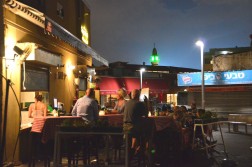
Officially, the city of Tel Aviv, Israel is known as “Tel Aviv-Jaffa,” a name that dates back to 1950, when Tel Aviv was merged with the old Arab port city of Jaffa.
Although Tel Aviv and Jaffa are now administratively joined, Jaffa could literally not be more different from Tel Aviv, as much as I love the city. While Tel Aviv is modern and dates back just over 100 years, Jaffa is believed to be the oldest port city in the world, with first mentions of the city dating as far back as 1400 B.C.
The next time you travel in Israel, make sure and visit the old city of Jaffa, located just a few minutes’ walk south of Central Tel Aviv along the Mediterranean.

Jaffa can be seen from any of Tel Aviv’s beaches
Location of Jaffa
Jaffa is located so close to Tel Aviv that you can see the old port city perched over the Mediterranean from any of Tel Aviv’s beaches.
The easiest and most pleasant way to travel from Tel Aviv to Jaffa is on foot. Simply walk onto Tel Aviv’s beach road, make a left and walk southward until you reach Jaffa. Depending on how fast you walk — and whether you find yourself compelled to pause and enjoy the beautiful scenery — it will take you between 30 minutes and one hour to reach Jaffa.
You can alternatively take a Dan bus from anywhere in central Tel Aviv to Jaffa or, alternatively, take a taxi from Tel Aviv to Jaffa.

Jaffa Clock Square at night
Jaffa Clock Square
The first thing you see when you arrive in Jaffa is the Jaffa Clock Square, which not surprisingly has the Jaffa Clock Tower as its centerpiece. The Jaffa Clock Tower was constructed in 1906 in honor of Ottoman Sultan Abdul Hamid II, a piece of architecture that’s relatively new as the ancient city of Jaffa goes.
Jaffa Clock Square is the beginning of Yefet Street, the main street of Jaffa. If you continue walking south along Yefet, you will eventually end up in the heart of Old Arab Jaffa.

Minaret of the Al-Bahr Mosque
Al-Bahr Mosque
Or, you could snap a few pictures of the clock tower, make an about-face — don’t worry, you’ll get to visit central Jaffa — and turn left, walking up a pathway that takes you along the Mediterranean seashore.
You’ll eventually end up at the picturesque Al-Bahr mosque, a structure that is believed to be the oldest existing mosque in Jaffa. Although it has appeared in art as far back as the late 17th century, when it was actually built is anybody’s guess.
After taking in the mosque, walk past the St. Peter’s Church and through the various gardens that exist along the sea. Afterwards, walk eastward and descend into central Jaffa, where heading south along Yefet would’ve taken you. Enjoy traditional Arab hummus or falafel here, or shop at any of Jaffa’s markets.

Yefet Street
The Significance of Jaffa
Jaffa is home to one of the largest remaining Arab populations in Israel proper, which is pretty remarkable once you travel in Israel a bit and see how, well, Jewish it is. As I was walking through Jaffa’s streets, I mentioned to my friends something along the lines of “Wow, I guess Arabs and Jews can live together in peace.”
Of course, I’m not ignorant. Jaffa is definitely not without its problems, which include drug use among residents, violence and other types of crimes. Arab residents feel that the Israeli government is trying to get rid of them, from changing Arab street names to Jewish ones to evicting low-income Arabs who live in public housing projects.
As a traveler visiting Israel, however, the fact that Jaffa even still exists makes me hopeful that Israel does at least have some intent of reconciling with its Arab citizens and neighbors.

Robert Schrader is a travel writer and photographer who’s been roaming the world independently since 2005, writing for publications such as “CNNGo” and “Shanghaiist” along the way. His blog, Leave Your Daily Hell, provides a mix of travel advice, destination guides and personal essays covering the more esoteric aspects of life as a traveler.








